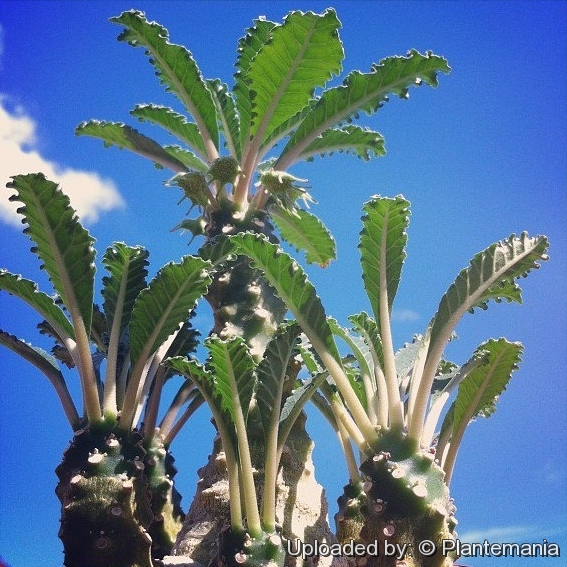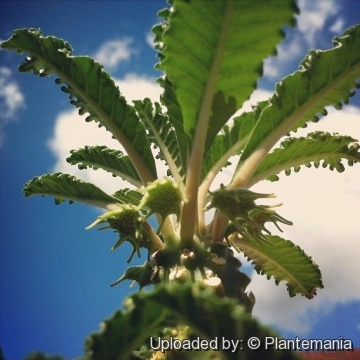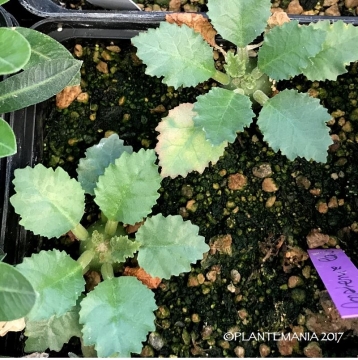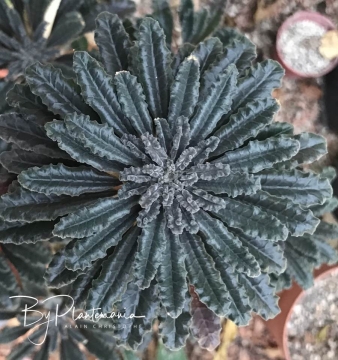
Dorstenia lavrani Photo by: © Plantemania
Origin and Habitat: North of Erigavo in the Taba'a Gap (Tabia Gorge), Northern Somalia (not known elsewhere.).
Altitude range: 100–1750 metres above sea level.
Habitat and ecology. This species may occur in shady moss filled cracks in a limestone gorge - this gives a clue to the growing conditions needed in cultivation.
Synonyms:
Description: Dorstenia lavrani is a many stemmed perennial plant which produced a symmetrical "grove" with many succulent wax-like stems patterned with spiraling rows of whitish leaf scars. Each stem is topped with a rosette of attractively crisped leaves. Overall, this plant has the appearance of a compact grove of palm trees, and is most attractive. Dorstenia lavrani is believed to represent the only species of Dorstenia which is dioecious - in which the male (pollinate) and female (pistillate) flowers, are born on separate plants. So to produce seed, plants of both sex are needed. This are required to set seed. This contrasts with other dorstenias that have flowers of both sexes on the same plant (and are therefore monoecious) so that seeds are freely produced from just a single plant. In addition to its ‘proper name’, it is also listed under various names such as Dorstenia Taba’a Gorge, Dorstenia species Mait Plateau and Dorstenia L&H 10341.
Stems: Succulent, simple, offsetting from at the base 1–2.5 cm thick and up to 20 cm tall, with pronounced spirally arranged leaf-, inflorescence- and stipule-scars.
Leaves: Alternate, crowded at the top of stems; stipules subulate from a broad base, 1–2 mm long, deciduous; petiole up to 5 mm long, puberulous; blade elliptic to obovate, 1.5–4.5 x 0.7–1.8 cm, subacute at the apex, with crenate and strongly undulate margins, ± puberulous on both surfaces or glabrous above.
Inflorescence. The flower's receptacle is produced in the leaf axils, on peduncles 5–15 mm long. The receptacle is open, circular in outline, 5–15 mm in diam. (excl. appendages), often flat or only moderately curved, folded or cupped - it has the general appearance of a fleshy greenish daisy, with long, fleshy appendages radiating outwards from its centre. Appendages 6–12, linear, unequal, up to 16 mm long. Male flowers numerous (about 200); tepals 2(–3); stamens 2–3. Female flowers about 80, stigma unbranched.
Bibliography: Major references and further lectures
1) Bruce Brethauer “Plant of the month: Dorstenia Lavrani; Tabia Gorge, Somalia” The Central Ohio Cactus and Succulent Society retrieved on 22 December 2016 <http://columbus-cactus-club.webs.com/Dorstenia%20Lavrani.htm>
2) Tina Wardlaugh “The sex life of Dorstenia lavrani” Northampton and Milton Keynes Branch of the B.C.S.S. retrieved on 22 December 2016 <http://northants.bcss.org.uk/nl222/nl222dorstenia.htm>
3) Dorstenia lavrani in the American Journal (CSJ Vol. 80, No.2, 2008)
4) Friis “Flora Somalia”, Vol 2, 1999) Author: by [updated by M. Thulin 2008]
 Dorstenia lavrani Photo by: © Plantemania
Dorstenia lavrani Photo by: © Plantemania Dorstenia lavranii seedlings. Photo by: © Plantemania
Dorstenia lavranii seedlings. Photo by: © Plantemania Dorstenia lavranii, Foliage 'under the sun of tropics' Photo by: © Plantemania
Dorstenia lavranii, Foliage 'under the sun of tropics' Photo by: © PlantemaniaSend a photo of this plant.The gallery now contains thousands of pictures, however it is possible to do even more. We are, of course, seeking photos of species not yet shown in the gallery but not only that, we are also looking for better pictures than those already present.
Read More... Cultivation and Propagation: Dorstenia lavraniSN|33332]]SN|33332]] needs bright light or partial to full shade, with warm temperatures and a well-drained soil mix that must not remain soggy for too long. During the growing season, the plants appreciate a fair amount of water but allow the soil to dry slightly between watering, making sure that they never dry out completely. They have to be kept in a rather high air humidity. They are fertilized once during the growing season with a balanced fertilizer diluted to ½ the strength recommended on the label. During the winter months they tend to go at least partially dormant and will exhibit some leaf loss. During this period, they should be given very little water.
Propagation: Dorstenias are usually propagated by seed. Seed germinate readily at 21° C. They can also be propagated by cuttings.













